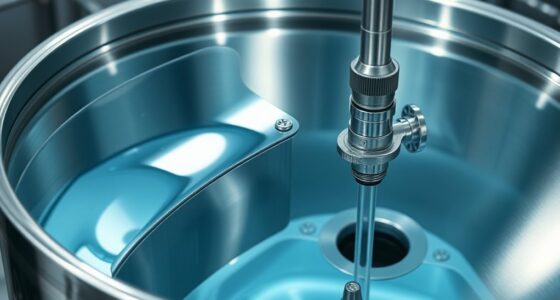Your plaster typically lasts 20-30 years, but cracks, damp patches, or mold signal it needs replastering sooner. Tiles can last over 50 years if well-maintained, but cracked, chipped, or loose tiles, along with damaged grout, indicate it’s time to retile. Regular inspections, proper maintenance, and addressing issues early help extend their lifespan. If you want to know more about the key signs and best timing, keep exploring the details.
Key Takeaways
- Replaster when walls show cracks, chips, damp patches, or mold to prevent further damage and maintain structural integrity.
- Retile if tiles are cracked, loose, discolored, stained, or grout is deteriorated to ensure water resistance and safety.
- Both surfaces typically need refurbishment after 20-30 years, depending on environmental conditions and maintenance practices.
- Regular inspections and timely repairs extend lifespan, while neglect accelerates deterioration requiring earlier replastering or retiling.
- Consider damage severity, budget, and surface purpose when choosing to replate or re-tile for optimal durability and cost-effectiveness.
Understanding the Typical Lifespan of Plaster and Tiles
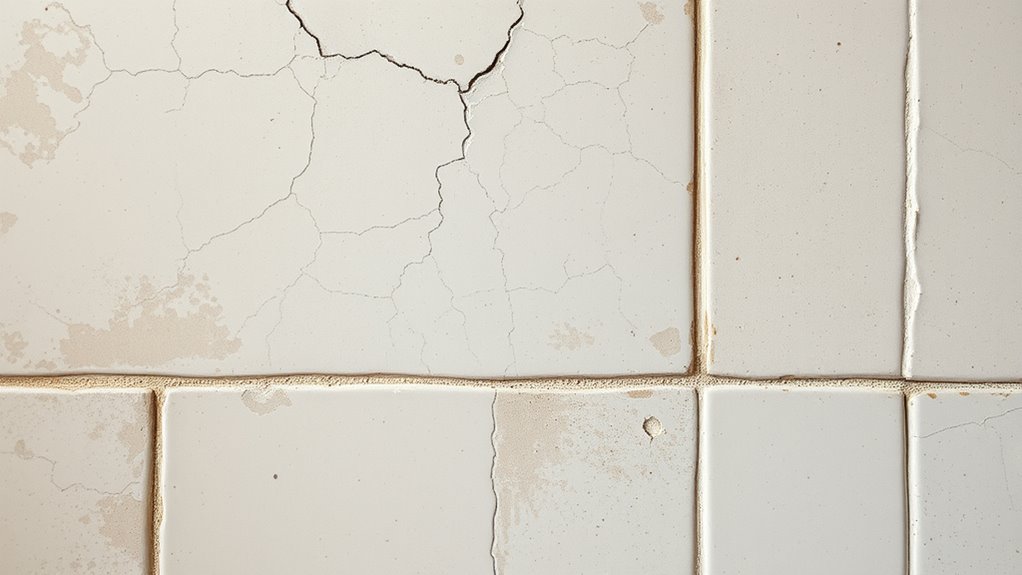
Understanding the typical lifespan of plaster and tiles is essential for maintaining the durability and appearance of your walls and surfaces. Plaster usually lasts between 20 to 30 years if properly applied and maintained. Over time, factors like moisture, temperature fluctuations, and physical damage can cause it to crack or crumble. Tiles tend to have a longer lifespan, often lasting 50 years or more, especially if they’re high-quality and properly installed. However, grout can deteriorate sooner, leading to water seepage and staining. Regular inspections can help you catch early signs of wear. Proper cleaning and maintenance extend these lifespans, but ultimately, knowing these timeframes prepares you for necessary repairs or replacements, ensuring your surfaces stay functional and attractive over the years.
Signs That Indicate Replastering Is Necessary
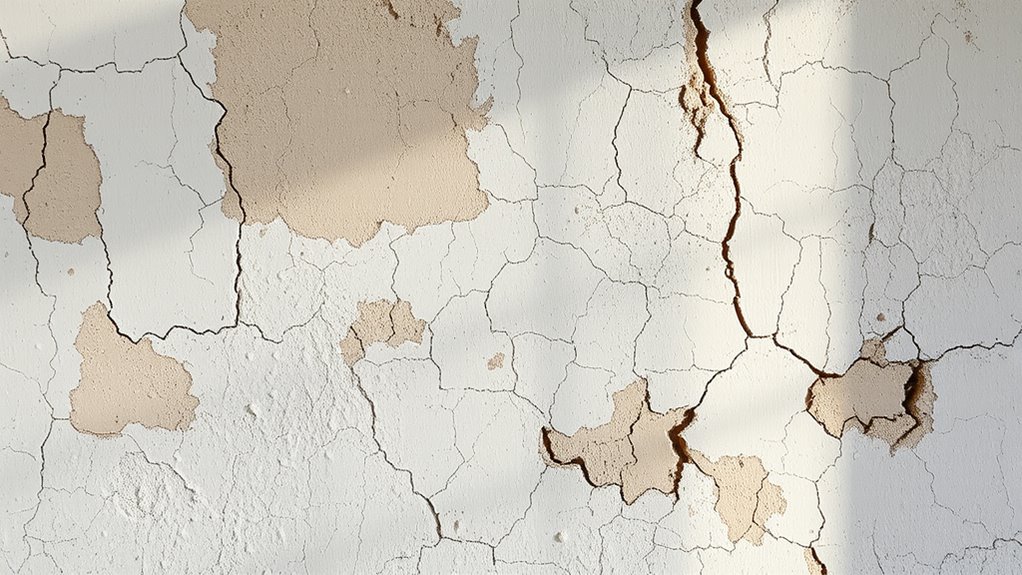
You’ll know it’s time to replaster when you notice cracks or chips appearing on your walls, as these weaken the surface. Damp patches or mold growth are clear signs that moisture is seeping in, indicating the plaster needs attention. Addressing these issues early can prevent further damage and maintain your wall’s integrity. Additionally, proper surface preparation is essential before replastering to ensure a durable and smooth finish.
Cracks and Chips
Have you noticed cracks or chips forming on your walls or ceiling? These are clear signs that your plaster may be deteriorating and needs attention. Small surface chips might seem minor, but larger or spreading cracks indicate deeper issues. Pay close attention to:
- Vertical or diagonal cracks that widen over time
- Multiple cracks radiating from a single point
- Chipped or flaking plaster revealing underlying surfaces
- Cracks accompanied by bulging or uneven surfaces
- Cracks that persist despite repairs
If you see these signs, it’s time to think about replastering. Ignoring cracks and chips can lead to further damage, moisture intrusion, or even structural problems. Addressing them promptly helps ensure your walls remain strong, smooth, and visually appealing. Additionally, monitoring for dampness or mold, which often accompanies deteriorating plaster, is essential for maintaining a healthy living environment.
Damp and Mold
Are damp and mold appearing on your walls or ceilings? If so, it’s a clear sign that your plaster may be compromised. Persistent damp patches or black mold spots indicate moisture seeping through the walls, which can weaken the plaster’s structure over time. You might notice a musty smell or peeling paint, both signs of ongoing moisture issues. If these problems persist despite ventilation efforts, it’s time to contemplate replastering. Mold not only damages your wall surfaces but also poses health risks. Replastering helps eliminate the source of moisture, seals the wall, and prevents mold from returning. Additionally, addressing moisture issues promptly can help prevent further damage to your building structure and ensure a healthier indoor environment. Don’t ignore these signs—addressing damp and mold early can save you from more costly repairs down the line.
Indicators It’s Time to Retile Your Surfaces
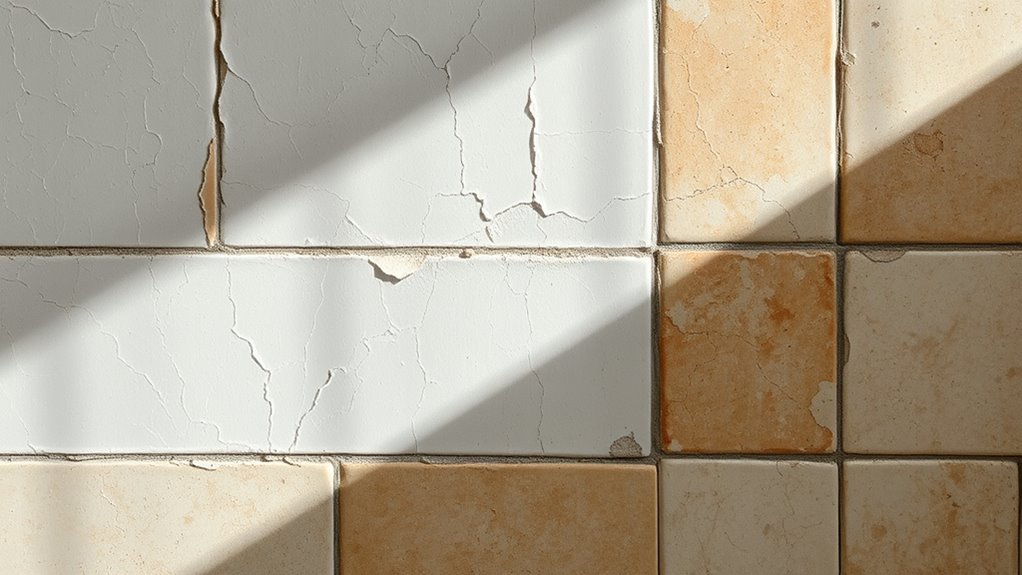
If you notice cracks, chips, or loose tiles, it’s a clear sign your surface needs attention. Persistent mold or mildew that won’t go away also indicates it’s time to retile. Addressing these issues promptly can prevent further damage and maintain a safe, attractive space. Using pimple patches as an analogy, timely intervention helps prevent larger problems down the line.
Visible Surface Damage
Noticing visible damage on your surfaces is a clear sign it’s time to contemplate retiling. Cracks, chips, or peeling tiles compromise both appearance and safety. You might also see uneven grout lines or discoloration that won’t clean or fade. These issues often indicate underlying problems that worsen over time. If the damage is extensive, it can lead to water leaks or mold growth, further damaging your space. Addressing surface damage early prevents more costly repairs later. Consider retiling if you notice:
- Cracked or shattered tiles
- Missing or loose grout
- Significant discoloration or staining
- Chips or surface pitting
- Persistent mold or mildew in grout lines
- Recognizing signs of angel number soulmate guidance can also signal it’s time for refurbishment.
Act promptly to restore your surfaces’ integrity and aesthetics.
Persistent Mold or Mildew
Persistent mold or mildew on your surfaces signals a clear need for retiling before the problem worsens. If you notice these growths lingering despite cleaning, it indicates that moisture is trapped beneath the surface, creating an ideal environment for mold to thrive. Retiling helps eliminate the source of ongoing moisture issues and provides a fresh, impermeable barrier to prevent future mold development. Ignoring persistent mold can lead to health problems, structural damage, and costly repairs down the line. Don’t delay retiling if mold keeps recurring after cleaning, as this suggests your current surface has reached its limit. Replacing old tiles with new, moisture-resistant materials offers peace of mind and a healthier environment for your home. Recognizing the importance of preventative measures can also help you maintain a mold-free space over time.
Factors That Influence the Durability of Wall and Floor Materials
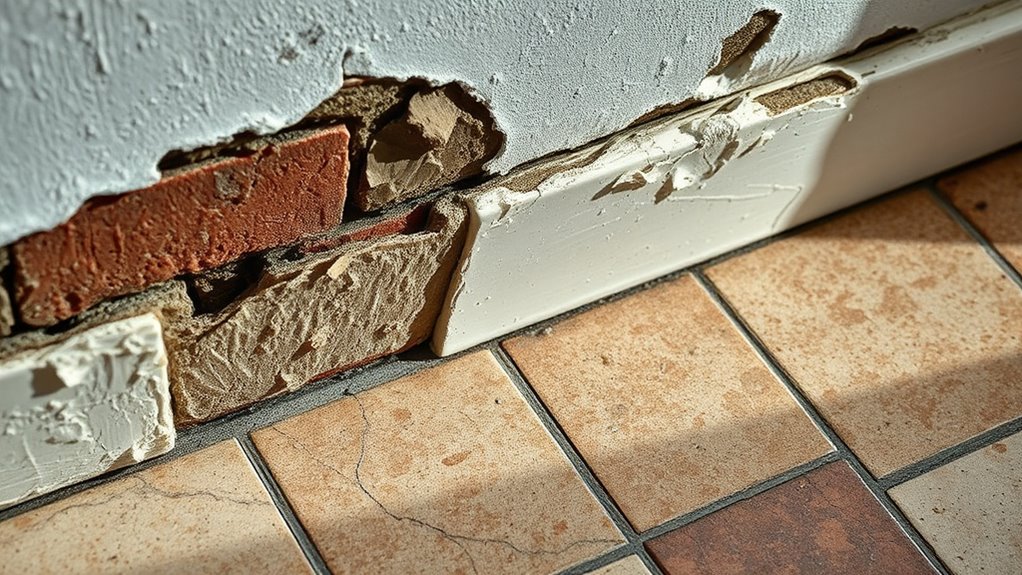
Several factors directly impact the durability of wall and floor materials, determining how well they withstand daily wear and environmental conditions. The quality of the materials you choose plays a vital role, as higher-grade options typically last longer. Proper installation is essential; even the best materials can fail if not installed correctly. Environmental factors, like moisture and temperature fluctuations, can accelerate wear, especially in humid or exposed areas. Maintenance habits also influence longevity—regular cleaning and prompt repairs extend lifespan. Ultimately, usage intensity matters; high-traffic spaces demand more durable surfaces. Additionally, understanding the electric bike components and their maintenance can help prevent damage caused by electrical issues, thereby preserving the integrity of your installed surfaces.
Comparing Costs and Benefits of Replastering vs. Re-tiling
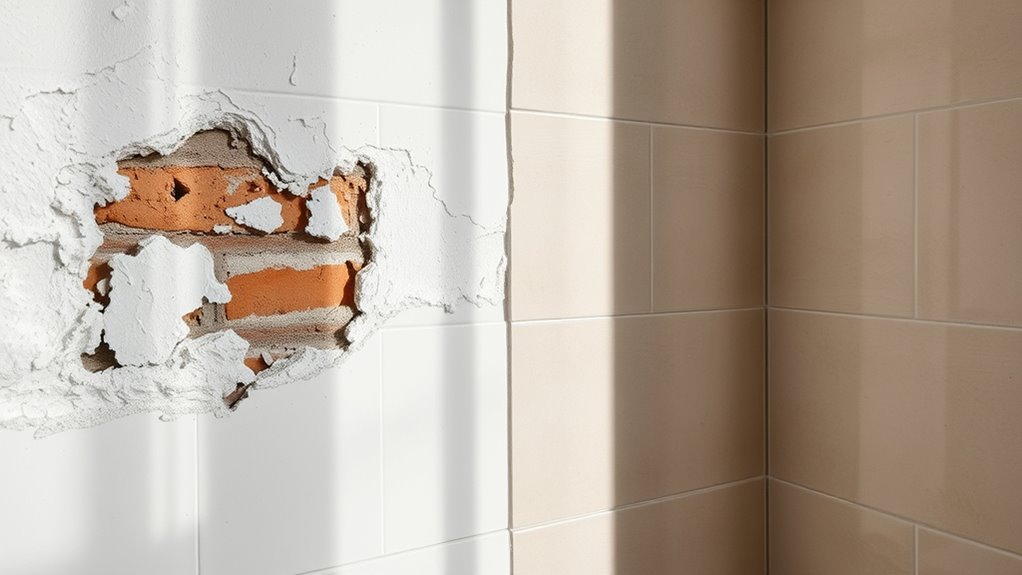
When deciding between replastering and re-tiling, understanding the costs and benefits of each option helps you make an informed choice. Replastering is generally more affordable upfront, especially if the wall surface remains structurally sound, and it allows for a smooth, seamless finish. However, it may require periodic maintenance if cracks or damp issues develop. Re-tiling typically costs more due to materials and labor but offers a durable, water-resistant surface that’s easier to clean and maintain over time. If your space is prone to moisture or heavy use, re-tiling might be worth the investment. Conversely, if aesthetics or quick refurbishment are priorities, replastering can be a cost-effective, less invasive solution. Considering the long-term durability of each option can help you choose the most suitable method for your needs. Weigh these factors based on your budget, purpose, and long-term needs.
Best Practices for Maintaining and Extending Material Lifespan
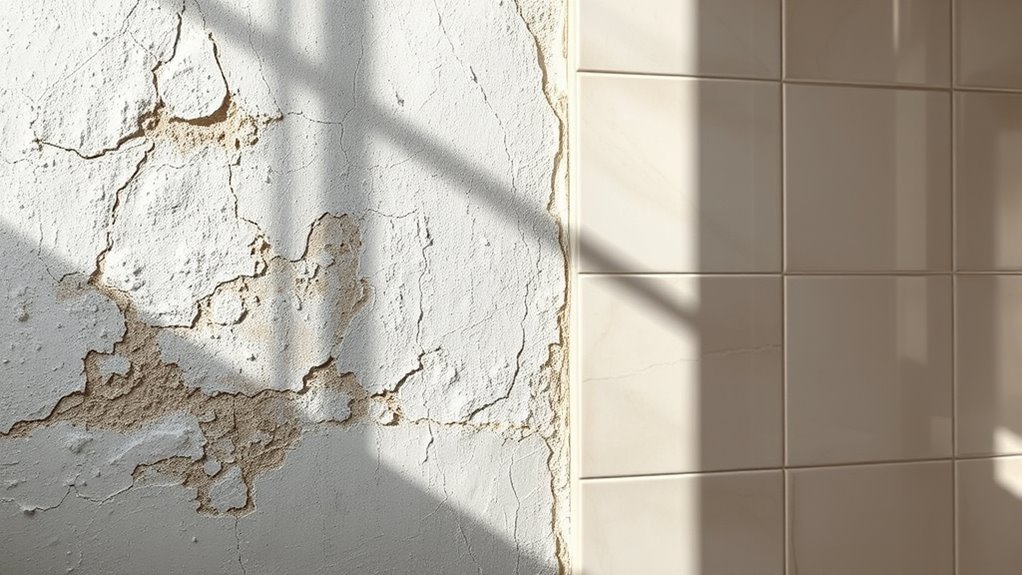
To maximize the lifespan of your surfaces, it’s essential to follow proper maintenance practices from the start. Regular upkeep prevents deterioration and prolongs their usability. Keep surfaces clean by using suitable cleaning agents, avoiding abrasive tools that can cause damage. Address spills and stains immediately to prevent permanent marks. Ensure proper ventilation to reduce moisture buildup, which can lead to mold and material breakdown. Periodically inspect for cracks, chips, or loose tiles, and fix issues early. Additionally, use protective coatings or sealants when recommended to shield surfaces from moisture and wear. Regularly monitor surface conditions to catch potential problems early and maintain their integrity.
- Clean surfaces regularly with non-abrasive cleaners
- Promptly repair minor damages before they worsen
- Apply sealants to vulnerable areas periodically
- Control humidity levels to prevent mold growth
- Use mats or protective pads in high-traffic zones
When to Consult Professionals for Repairs and Refurbishments
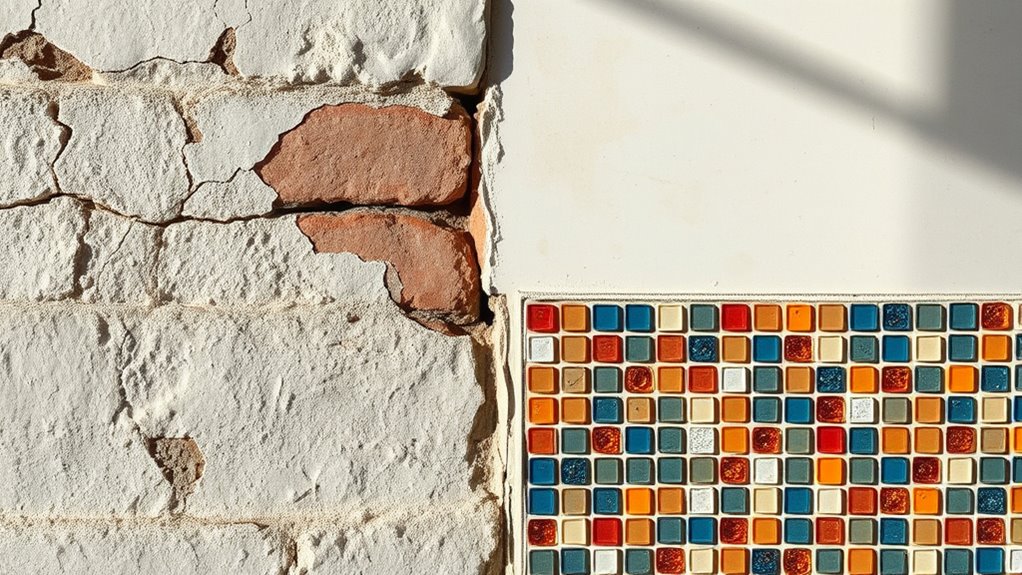
Knowing when to call in professionals can save you time and prevent further damage. If cracks appear that worsen over time or if water damage or mold develops, it’s time to seek expert help. Attempting complex repairs without proper skills can lead to costly mistakes. When your efforts don’t resolve issues or if repairs seem beyond your scope, professionals can accurately diagnose problems and recommend effective solutions. Consider calling specialists if surfaces show signs of structural damage, persistent leaks, or electrical or plumbing issues related to refurbishment projects. Hiring experts ensures the work complies with safety standards and lasts longer. Additionally, building codes and safety standards should always be adhered to during repairs, reinforcing the importance of consulting professionals. Don’t hesitate to consult professionals early—doing so preserves your investment, maintains safety, and often saves money in the long run.
Frequently Asked Questions
How Do Environmental Conditions Affect the Lifespan of Plaster and Tiles?
Environmental conditions greatly impact the lifespan of plaster and tiles. Excess moisture, humidity, and temperature fluctuations can cause plaster to crack or degrade faster, while tiles may loosen or develop mold. You should guarantee proper ventilation and sealing to protect your surfaces. Regular maintenance helps, but if environmental damage is severe, replastering or retiling becomes necessary to preserve aesthetics and structural integrity.
Can DIY Repairs Extend the Life of Plaster or Tiles Effectively?
Yes, DIY repairs can effectively extend the life of plaster or tiles if you do them correctly. You need to properly prep the surface, use suitable materials, and follow proper techniques. Small cracks or chips, if repaired promptly, prevent further damage and water infiltration. However, avoid shortcuts or skipping steps, as poor repairs can worsen issues over time. With careful work, you can prolong the lifespan of your surfaces appreciably.
What Are the Environmental Impacts of Replastering Versus Re-Tiling?
Replastering generally has a smaller environmental footprint than re-tiling, which involves more waste and resource use. Did you know that tile production emits up to 0.5 metric tons of CO2 per 1,000 square meters? Replastering uses fewer materials and generates less waste, making it a more eco-friendly choice. By choosing to replaster, you reduce landfill waste and conserve natural resources, helping protect the environment.
Are There Eco-Friendly Materials Suitable for Refurbishment Projects?
Yes, there are eco-friendly materials suitable for refurbishment projects. You can choose recycled or reclaimed tiles, which reduce waste and resource use. Lime plaster is a sustainable alternative to traditional cement-based plaster, as it has lower carbon emissions and better breathability. Additionally, clay-based paints and natural sealants are eco-friendly options that minimize chemical emissions. Using these materials helps you reduce your environmental footprint while maintaining quality and durability.
How Does Interior Design Style Influence Material Choice and Refurbishment Timing?
Your interior design style guides your material choices and refurbishment timing. For a modern look, opt for sleek, minimalistic materials like glass or metal, which may require quicker updates to stay fresh. If your style is traditional, choose classic tiles or plaster finishes that age well and can be refurbished less frequently. Always consider the durability and aesthetic harmony with your style to determine when to replate or retile, ensuring your space remains cohesive.
Conclusion
Knowing when to replaster or retile is like tending a garden—you need to listen to the signs and act before problems take root. Regular maintenance keeps your surfaces healthy and vibrant, preventing issues from spreading like weeds. When cracks or chips appear, don’t ignore them; it’s your cue to nurture your space back to life. With timely repairs, your walls and floors will continue to tell a story of beauty and resilience for years to come.





